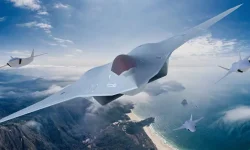- Views: 3K
- Replies: 37
The rapid advancements in sixth-generation fighter aircraft development by nations like China and the United States are prompting strategic recalculations globally. Within India's defence circles, a significant debate is emerging regarding potential participation in the Global Combat Air Programme (GCAP), spearheaded by the UK, Italy, and Japan.
A key consideration is whether aligning the engine technology for India's indigenous Advanced Medium Combat Aircraft (AMCA) with the GCAP could offer a pathway to maintaining air power parity, particularly concerning China's evolving capabilities. Such a collaboration could potentially position India with both its 5.5-generation AMCA and access to a sixth-generation platform around 2035, mitigating historical delays in military aviation procurement.
Recent displays of next-generation air combat technology, including China's reported unveiling of a tailless, stealthy sixth-generation prototype in late 2024 and ongoing progress in the U.S. Next Generation Air Dominance (NGAD) program, highlight a technological leap.
These future aircraft are expected to incorporate enhanced stealth, artificial intelligence, autonomous systems, and advanced networked warfare capabilities, surpassing current fifth-generation fighters like the F-35 and J-20.
For the Indian Air Force (IAF), which is currently working to bolster its squadron numbers and modernize its fleet, the prospect of falling technologically behind regional adversaries, especially China, is a significant strategic concern.
The GCAP initiative, formally launched in December 2022, represents a major collaborative effort between Japan (Mitsubishi Heavy Industries), Italy (Leonardo), and the UK (BAE Systems) to develop and field a sixth-generation fighter by 2035. This aircraft aims to integrate cutting-edge features such as advanced sensor suites, potential directed-energy weapons, and seamless operation with unmanned aerial systems.
Reports indicate that the UK and Italy have extended invitations to India to join the program, with Japan potentially amenable. Proponents suggest Indian participation could help distribute the substantial estimated development costs (around $32.5 billion) and leverage India's growing aerospace industrial base.
A major draw for India could be the possibility of using the same advanced engine, likely involving Rolls-Royce, for both the GCAP fighter and its own AMCA project, simplifying logistics and development.
India's AMCA, currently under development by the Defence Research and Development Organisation (DRDO) and the Aeronautical Development Agency (ADA), is envisioned as a 5.5-generation stealth aircraft.
The initial Mk1 version is projected to make its maiden flight around 2029-30 and enter service by 2035, initially powered by American General Electric F414 engines.
The subsequent AMCA Mk2 variant requires a more powerful engine in the 110-130 kN thrust class, planned to be co-developed with an international partner. Major engine manufacturers like Safran (France), Rolls-Royce (UK), and General Electric (USA) are reportedly in contention for this collaboration.
Aligning this Mk2 engine development with the GCAP engine program could potentially provide the AMCA with a state-of-the-art powerplant while giving India access to sixth-generation engine technologies, such as adaptive cycle designs which promise improved fuel efficiency and thermal management.
Strategically, achieving synergy could allow India to operate both the domestically developed AMCA Mk2 and a GCAP-derived sixth-generation fighter by the mid-2030s. This timeline would place India alongside the US, China, and the core GCAP nations in terms of deploying comparable advanced air combat platforms, representing a significant shift from previous patterns where indigenous platforms faced considerable delays entering service.
Some commentators, reflecting discussions on social media platforms, argue that joining GCAP could provide valuable experience and prevent potential delays in accessing sixth-generation capabilities, complementing the AMCA.
However, joining the GCAP consortium as a full partner is not without potential drawbacks and criticism. Concerns exist that participation could dilute India's focus on self-reliance ("Atmanirbhar Bharat") in defence manufacturing, potentially relegating India to a secondary role despite financial contributions.
Furthermore, the AMCA Mk2 itself is intended to incorporate features associated with sixth-generation aircraft, such as advanced data fusion, AI, and potential integration of directed energy systems, leading to questions about redundancy if India also invests heavily in GCAP.
Some analysts suggest that focusing solely on engine co-development, rather than full platform partnership, might be a more prudent approach, securing vital propulsion technology without the complexities of a full international program partnership. Both Rolls-Royce and Safran have reportedly offered significant technology transfer, including full intellectual property rights, for the AMCA engine project.
Ultimately, India faces a complex decision. Aligning the AMCA Mk2 engine with GCAP offers a potential route to accelerate development and gain access to cutting-edge technology. This could support the IAF's goals of fielding approximately 126 AMCA jets post-2035 alongside potential GCAP fighters, addressing its current squadron shortfall and providing a credible counter to the anticipated expansion and modernization of China's air force in the coming decade.
The final choice will likely involve balancing the ambition for technological parity and international collaboration against the long-term goals of indigenous development and strategic autonomy.

